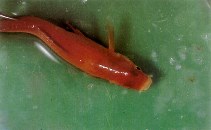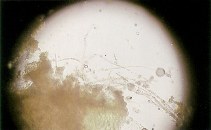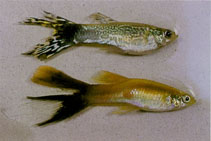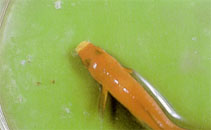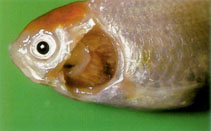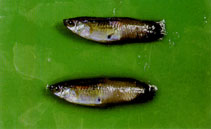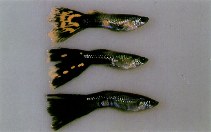| Hatchery-reared Salmonidae (fry) and Ictaluridae (juveniles). |
| This early stage shows elevated light blotches on dorsal trunk. It originates at the tail or dorsal fin and extends as a pale white patch on the body. The bacteria destroys gill tissue resulting in difficulty in breathing and wobbling. Aberrant behaviour is also exhibited like the fish becomes listless, rest on the bottom or hang at the surface. The fish looses it's color and lesions with red edges. Ref. 48502. |
| Furanace 1.5 mg/ l, bath for 1 hour for 1 to 3 days. Can also be cured with some anti-bacterial medicines like, Neomycine (Dose: 2-4 gm/100 l for 3 days, with a 30-50% water change afterwards.), Pennicillin (Dose: 1, 5-2gm/100L for 24 hours), Nitrofurazone (Dose: 250-500 mg/100 l for 3 days, with at least 50% water change after treatment.), Nifurpirinol (Dose: 10-15 mg/100 l for an unlimited time or as instructed), Furaltadone, Sulfonamide or Quinolones (Oxilinic Acid/Naladixic Acid/Ciprofloxacine/Flumequine; Dose: 500 mg/L for 1 hour, 100-200 mg/100L for 1-2 days. Mixed in the food: 250-500 mg/100 gm food, to be fed during 5-7 days). Start the treatment on the first signs of the disease that can be observed. In the beginning stage of the disease, the use of Copper Sulphate or a short bath with Benzalkonium Chloride or Salt could be effective. Ref. 41805. |
| Reduce population density. |
| Bacterial Gill Disease is a respiratory disease of juvenile hatchery-raised fish. A complex of environmental, physiological and bacterial factors are involved in causing an outbreak. The disease occurs most frequently in the springtime when the fish are actively growing and are crowded in waters of low oxygen and high ammonia. The bacteria involved are for the most part, unspecified bacteria. But Flexibacter columnaris which is a synonym of Flavobacterium columnare (Ref. 48502), has been implicated on several occasions (Ref. 48984). |
| high (30% - 60%) |
|
